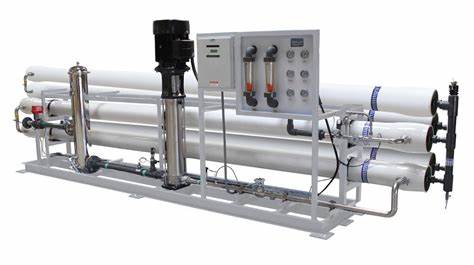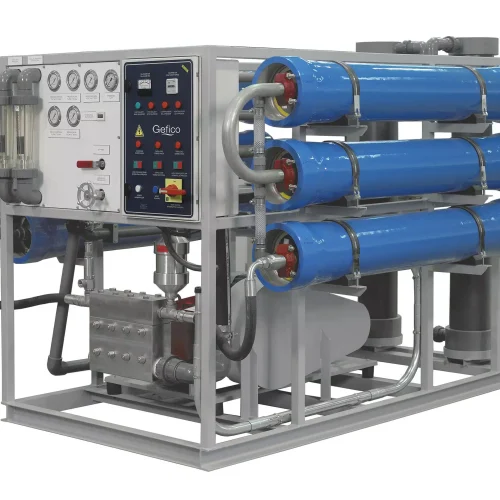We offer Reverse osmosis (RO) is a water purification technology that uses a semipermeable membrane to remove ions, molecules, and larger particles from drinking water. In reverse osmosis, an applied pressure is used to overcome osmotic pressure, a colligative property, that is driven by chemical potential differences of the solvent, a thermodynamic parameter. Reverse osmosis can remove many types of dissolved and suspended species from water, including bacteria, and is used in both industrial processes and the production of potable water. The result is that the solute is retained on the pressurized side of the membrane and the pure solvent is allowed to pass to the other side. To be “selective”, this membrane should not allow large molecules or ions through the pores (holes), but should allow smaller components of the solution (such as solvent molecules) to pass freely.
FEATURES OF REVERSE OSMOSIS
1. Removal of dissolved salts
2. Energy-saving separation technique
3. Utilizable as a concentration and recovery method
4. Compact equipment
5. Simple operation and control

Applications of Reverse Osmosis:
This technology has advantage of amembrane based process where concentration and separation is achieved without a change of state and without use of chemicals or thermal energy, thus making the process energy efficient and ideally suited for recovery applications. The bibliographic review shows applicability of RO system for treating effluents from beverage industry, distillery spent wash, ground water treatment, recovery of phenol compounds, and reclamation of wastewater and sea water reverse osmosis (SWRO) treatment indicating efficiency and applicability of RO technology.


Reverse Osmosis water filtration system
Reverse Osmosis (RO) is a method that removes dissolved particles and pollutants from water by passing water through a semi-permeable RO membrane while leaving the bulk of dissolved solids and other contaminants behind. RO membranes require water to be under high pressure (higher than osmotic pressure) to do this. The “permeate” is the water that goes through the RO membrane, while the “concentrate” is the dissolved salts that are rejected by the RO membrane. A well functioning RO system can remove 99.5% of incoming dissolved salts and contaminants.
Industrial reverse osmosis systems operate on a considerably greater scale. Reverse Osmosis typically involves three to five steps. A three-stage system includes a sediment filter, a carbon filter, and a semipermeable membrane. The five-stage method includes a final post-filtration step where the feedwater is passed through a carbon filter to remove any remaining pollutants. Some five-step Reverse Osmosis systems include a remineralization stage that recovers useful minerals lost during the original process.
Industrial reverse osmosis systems typically work in five fundamental phases. The initial step is prefiltration. This involves passing the feedwater through two pre-filters, which are standard in all Reverse Osmosis systems. The first is a sediment filter, which eliminates particles such as dust, grime, and rust. The second filter, comprised of activated carbon, eliminates chemicals such as chlorine and volatile organic compounds (VOCs). The second step is the actual reverse osmosis. At this step in the operation, the continuous pump delivers feedwater across a semipermeable membrane, which traps smaller, harder-to-detect contaminants. This stage eliminates the majority of the feedwater’s dissolved solids.The next phase is drainage. This is when the pollutants in the feedwater are collected and discharged. This procedure ensures that the membrane remains clean and transparent, allowing for more feedwater to be cleaned while maintaining the RO system’s efficiency high. The final step is to store the cleansed water. Typically, the water is held in a pressure vessel big enough to hold the cleaned water until it is ready for use. The water may additionally pass through a final charcoal filter to remove any remaining contaminants.
Reverse osmosis is an extremely successful treatment method for brackish, surface, and ground water in both large and small flow applications. Pharmaceutical, boiler feed water, food and beverage, metal finishing, and semiconductor production are some of the industries that use RO water.
